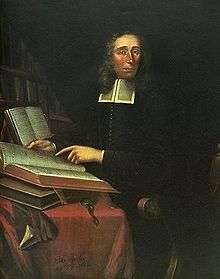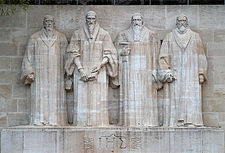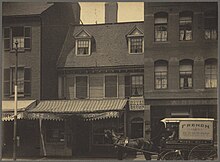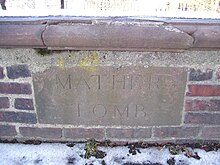Increase Mather
Increase Mather | |
|---|---|
 Mather in 1688, when he was in London. Portrait byJohn van der Spriett. | |
| President ofHarvard College(title varied) | |
| In office 1685–1701 | |
| Preceded by | John Rogers |
| Succeeded by | Samuel Willard(acting) |
| Personal details | |
| Born | June 21, 1639 Dorchester,Massachusetts Bay Colony,British America |
| Died | August 23, 1723 (aged 84) Boston,Province of Massachusetts Bay,British America |
| Spouse(s) | Maria Cotton Ann Cotton |
| Children | Cotton Mather |
| Education | Harvard College(AB) Trinity College Dublin(MA) |
| Occupation | Ministerand author |
| Signature | |
| Part ofa serieson |
| Reformed Christianity |
|---|
 |
|
|
Increase Mather(/ˈmæðər/;June 21, 1639Old Style[1]– August 23, 1723 Old Style) was aNew EnglandPuritanclergyman in theMassachusetts Bay Colonyand president ofHarvard Collegefor twenty years (1681–1701).[2]He was influential in the administration of the colony during a time that coincided with the notoriousSalem witch trials.
Early life
[edit]The New England Mathers originally came from the parish ofWinwicknearLiverpool,inLancashire,England.[3]Increase Mather was born inDorchester,Massachusetts Bay Colony,[4]on June 21, 1639, to the Rev.Richard Matherand Kathrine Holt Mather,[5]following their participation in theGreat Migrationfrom England due to theirnonconformityto theChurch of England.[6]
The stated reason for his first name was "…the never-to-be-forgottenincrease,of every sort, wherewith God favoured the country about the time of his nativity. "[7]The name "Increase"is a literal translation of the Hebrew" Yosëf "(Joseph).[8]He was the youngest of six[9]brothers, the others being Samuel, Nathaniel, Eleazar, Joseph, and Timothy.[9]The first three of these also became ministers.[10]
Education
[edit]In 1651, Mather was admitted toHarvard College,where he roomed with and studied under Robert Massey. When he graduated in 1656, aged 17, with aBachelor of Arts,[5]he began to train for theministry,and gave his first sermon on his 18th birthday.[7]He quickly left Massachusetts and went to Ireland, where he studied atTrinity College, Dublin,for aMaster of Arts.During his time at Trinity College he was licensed as a Commonwealth Minister byOliver Cromwell[11]to the joint charge of St Tida's Church (Ballyscullion), and St Swithan's Church (Magherafelt).[12]He graduated in 1658, and worked as achaplainattached to a garrison in theChannel Islandsfrom 1659 to 1661 with a short stint at a church in Gloucester in 1660.[13]
After Cromwell's death in 1658, Mather felt less secure in his post in the Channel Islands due toCharles II's return to the throne.[14]He resigned the position in 1660 and sailed for Boston in 1661.[14]Harvard later awarded Mather the firsthonorary degreein theNew World;he became aDoctor of Sacred Theologyin 1692.[5]
Massachusetts
[edit]
In 1661, with the advent of theEnglish Restorationand resurgence ofAnglicanism,Increase returned to Massachusetts where he married Maria Cotton. She was his step-sister by virtue of his father's marriage to Sarah Hankredge, widow ofJohn Cottonand mother of Maria.[7]Maria gave birth toCotton Matherin 1663. In 1676, Increase publishedA Brief History of the War with the Indians in New-England,[15]a contemporary account ofKing Philip's War.
He wasordainedas minister of theNorth Church.[a]He held this post until he died.[4]
Harvard College
[edit]In his autobiography, Increase Mather writes that he wasPresident of Harvardfrom 1681 until 1701,[1][page needed]but due to charter and organizational changes, his official title varied. On June 11, 1685, he was made Acting President and on July 23, 1686, he was appointedRector.On June 27, 1692, he finished writing the new college charter and became president.[5]On September 5, 1692, while the Salem trials were still ongoing, Increase Mather was awarded a doctorate of divinity, the first doctorate issued at Harvard, and the last for 79 years.[16]
He was rarely present on campus or in the town, especially during his term of Rector, as he was out of the Colony for all but two years of his term in that office. Despite his absences he did make some changes: re-implementation ofGreekandHebrewinstruction, replacement of classical Roman authors withBiblicaland Christian authors inethicsclasses, enactment of requirements that students attend classes regularly, live and eat on campus, and that seniors nothazeother students.[5]
Politics
[edit]While politics and Puritan religion were closely related during Increase's lifetime, his first direct involvement with politics occurred as a result ofJames II of England's manipulation of the New England governments. In 1686, James revoked theCharter of Massachusettsin the process of creating theDominion of New England.[4]
The Dominion was headed byEdmund Andros,who not only disliked puritanism and was haughty,[5]but ruled as a near-absolute dictator:Town meetingswere outlawed, leaving the Dominion withoutconsent of the governed,marriage was removed from the clergy, and theOld South Churchwas temporarily appropriated forAnglicanservices.[17]
The 1687Declaration of Indulgence,prohibiting discrimination againstCatholics,saw staunch opposition from the Puritan establishment. When Mather successfully roused opposition to revocation of the charter, he was nearly framed fortreason.He traveled to London (eluding spies out to catch him) to petition the King. While engaged in petitioning he published pieces to build popular support for his positions, such asA Narrative of the Miseries of New-England, By Reason of anArbitrary GovernmentErected there Under Sir Edmund Andros(1688) andA Brief Relation for the Confirmation of Charter Privileges(1691).[7]
He attempted to restore the old charter[4]and obtain a royal charter for Harvard; however, he abandoned that course and changed his petitions, favoring a new charter not lacking any of the rights previously granted. Following theGlorious Revolutionandsubsequent overthrowof Andros, a new charter was granted to the colony.[5]The 1692 charter was a major departure from its predecessor, granting sweepinghome rule,establishing an electivelegislature,enfranchising allfreeholders(previously only men admitted to a congregation could vote), and uniting the Massachusetts Bay Colony andPlymouth Colony.[5]Following Andros' deposition and arrest,[17]he hadWilliam Phipsappointed as Royal Governor and they returned to Massachusetts, arriving on May 14, 1692.[18]Following his return, the administration of Harvard grew increasingly insistent that he reside nearer to the institution. Not wanting to leave his Second Church, he did not do so, and eventually resigned the Presidency.[5]
Salem witch trials
[edit]In 1681, the same year he became president of Harvard (and when his sonCotton Matherwas only eighteen years old), Increase Mather began work on a manuscript that was to be a collection of "illustrious providences" and he solicited contributions from the other Puritan ministers.[19]This work demonstrated a belated interest in witchcraft relative to the European continent, where witch trials had gone into a steep decline after reaching "peak intensity during the century 1570–1670" but this reflected a similar belated interest among a certain milieu in London around the same time.[20]Increase Mather's bookRemarkable Providenceswas published in 1684 and forwards a doctrinal belief in the real power of witchcraft. One of the more curious aspects of the book is that while it cites numerous Reformation theologians (Luther, Beza, Melancthon) and many well-known writers on witchcraft including Dominican inquisitorHeinrich Kramer(author of the notorious witch-hunting manualMalleus Maleficarum),[21]it does not citeJohn Calvin.
In November 1692, he publishedCases of Conscience Concerning Evil Spiritswhich defended the judges and trials, but also expressed words of caution, perhaps due to public pressure. In the postscript, included with the initial first edition of the book, he mentions his own attendance at the trial of George Burroughs and his agreement with the capital judgment against him.George Burroughshad been a fellow minister who seems to have substituted at the pulpit for Increase Mather on at least one occasion.[22]Like his work from 1684, this 1692 work also citesMalleus Maleficarum.[23]
Notwithstanding this, his reputation was not improved afterwards or for posterity due to his association with the trials as well as his subsequent refusal, for whatever reasons, to denounce them.[18]He was also briefly mentioned in a thorough treatment of his son Cotton byRobert Calefin his comprehensive book of the Salem Trials and their aftermath,More Wonders of the Invisible World[24](referred to asMore Wonders of the Spiritual Worldby theEncyclopædia Britannica Eleventh Edition).[7]Increase Mather was said to have burned Calef's book inHarvard Yard.
Later life and death
[edit]
In 1715, following the death of his wife Maria the previous year, he married Ann Cotton, widow of his nephew John.[25]
Mather owned aslavenamed Spaniard.[26]
On September 27, 1722, hefaintedand was thereafter bedridden. In August 1723 he sufferedbladder failureand died three weeks later on August 23, 1723, inBoston,aged 84. He was buried inCopp's Hill Burying Ground.[27]
Before his death, he took lodging at the retreat of Mineral Spring Pond to recover from his illness and drink from the famous healing waters of the springs fromSpring Pond.[28]
Beliefs
[edit]Throughout his life Mather was a staunch Puritan, opposing anything openly contradictory to, mutually exclusive with, or potentially "distracting" from, his religious beliefs. He supported suppression ofintoxication,unnecessary effort on Sundays andostentatious clothing.He was initially opposed to theHalf-Way Covenantbut later supported it. He firmly believed in the direct appearance of God's disfavor in everyday life, e.g. the weather, political situations, attacks by Native Americans, fires and floods, etc.[7][18]
He was strenuous in attempting to keep people to his idea of morality,[5]making strong use ofjeremiadsto try to prevent indifference and especially to try to get government officials to enforce public morality. During his tenure at Harvard he regularly stamped out any relaxation of Puritan strictness, such aslatitudinarianism,which had flourished during his overseas absence.[5]
Following his acceptance of the Covenant,Solomon Stoddardand others attempted to further liberalize Puritanism bybaptismof children who had nonmember parents[5]and admittance of all but the openly immoral to services. To try to stop this, Mather had asynodcalled to outlaw similar measures. A declaration was adopted, but never made binding.[7]
In popular culture
[edit]InJohn Neal's 1828 novelRachel Dyer,Increase Mather appears at the end ofMartha Corey's witchcraft trial to announce the guilty verdict and give a speech.[29]He is also played byStephen Langin the 2014 TV seriesSalem.[30][31] Increase Mather also appears inAct of Oblivion(2022) byRobert Harris.
Portraiture
[edit]A portrait of Increase Mather hangs in the Middle Common Room ofMansfield College, Oxford.[32]
See also
[edit]Notes
[edit]- ^The original Old North meetinghouse, not to be confused with the Anglican/EpiscopalOld North Church.
References
[edit]- ^abMather 1961.
- ^Mather 1961,p. 351, "From my first being chosen president of the College (1681) to my resigning my Relation to that society (1701) was full 20 years."
- ^Murdock 1925,pp. 11–12.
- ^abcd"Mather, Increase".The Columbia Encyclopedia(6th ed.). Bartleby. 2001–2005. Archived fromthe originalon 2007-12-03.Retrieved2006-10-12.
- ^abcdefghijkl"Mather, Increase, 1639–1723. Papers of Increase Mather: an inventory".Harvard University. Archived fromthe originalon 2006-09-02.Retrieved2006-10-12.
- ^"Richard Mather".Dorchester Atheneum.August 17, 2003.Archivedfrom the original on 2006-09-06.Retrieved2006-10-12.
- ^abcdefgWebster, Richard (1911)..InChisholm, Hugh(ed.).Encyclopædia Britannica.Vol. 17 (11th ed.). Cambridge University Press. pp. 884–85.
- ^"Genesis 30".Hebrew – English Bible.Mechon-Mamre.Retrieved2020-01-04.
- ^abThe Twentieth Century Biographical Dictionary of Notable Americans.Vol. VII. Boston: The Biographical Society. 1904.— The relevant excerpt can be seenhere
- ^Webster, Richard (1911)..InChisholm, Hugh(ed.).Encyclopædia Britannica.Vol. 17 (11th ed.). Cambridge University Press. pp. 885–86.
- ^Davis, Graeme (2017-10-03).Colonial Horrors: Sleepy Hollow and Beyond.Pegasus Books.ISBN978-1-68177590-6– via Google books.
- ^Miller, Kerby A.; Schrier, Arnold; Boling, Bruce D.; Doyle, David N. (2003-03-27).Irish Immigrants in the Land of Canaan: Letters and Memoirs from Colonial and Revolutionary America, 1675–1815.Oxford University Press.ISBN978-0-19534822-4– via Google books.
- ^Middlekauff, Robert (1999-06-29).The Mathers: Three Generations of Puritan Intellectuals, 1596–1728.University of California Press.ISBN978-0-52021930-4– via Google books.
- ^abGoldman, Samuel (2018-02-20).God's Country: Christian Zionism in America.University of Pennsylvania Press.ISBN978-0-81225003-9.
- ^Profile,Digital commons, UNL; accessed December 24, 2014.
- ^Pierce, Benjamin 1833A History of Harvard University,p. 64, via Google books.
- ^ab"E. Andros".Governors of Massachusetts.Commonwealth of Massachusetts.Retrieved2006-12-14.
- ^abc"Biography of Increase Mather".UMKC Law. Archived fromthe originalon 2006-11-07.Retrieved2006-10-12.
- ^Remarkable Providences,p. xxxii, via Google books.
- ^Weyer 1998,p. xvi.
- ^Weyer 1998,p. 140.
- ^Diary of Increase Mather1675–1676. Samuel A Green, Cambridge, 1900. p 8. See entry for April,1675. Via Google books.
- ^Bound together with his son's work from late 1692, in London edition and reprinted in 1862:Wonders of the Invisible Worldp. 270, via Google books.
- ^"More wonders of the invisible world".University of Virginia.Retrieved2006-12-09.
- ^"Increase Mather",Britannica; accessed March 3, 2018.
- ^Natanson, Hannah (22 February 2017)."Mather House Exhibit Scrutinizes Slaveholding Namesake's Past".The Harvard Crimson.Retrieved6 May2019.
- ^"MHS Increase Mather Papers, 1659–1721 Guide to the Microfilm Edition".Massachusetts Historical Society.2006-10-21.
- ^"The Register of the Lynn Historical Society".The Society. April 28, 1912 – via Google Books.
- ^Richards, Irving T. (1933).The Life and Works of John Neal(PhD thesis). Cambridge, Massachusetts:Harvard University.pp. 700–701.OCLC7588473.
- ^Sokol, Tony (May 20, 2015)."Stephen Lang Interview: Salem's Most Feared Witch-Hunter Speaks".Den of Geek.Retrieved2018-03-04.
- ^Goldman, Eric (May 30, 2014)."Salem Exclusive Clip: Stephen Lang Makes His Debut as a Formidable Witch Hunter".IGN.Retrieved2018-03-04.
- ^"Increase Mather".Art UK.RetrievedMay 30,2016.
Bibliography
[edit]- Mather, Increase (October 1961),"Autobiography"(PDF),AAS Proceedings,American antiquarian
- Weyer, Johann (1998). Kohl, Benjamin J.; Midelfort, H.C. Erik (eds.).On Witchcraft.Translated by Shea, John. Pegasus Press.ISBN978-1-88981802-3.
- Murdock, Kenneth Ballard (1925).Increase Mather. The Foremost American Puritan.Cambridge, Massachusetts: Harvard University Press.doi:10.4159/harvard.9780674429420.
Further reading
[edit]- Baker, Emerson W.A Storm of Witchcraft: The Salem Trials and the American Experience(2014)
- Michael G. Hall.The Last American Puritan: The Life of Increase Mather.Wesleyan, 1992.
- Thomas James Holmes.Increase Mather: a Bibliography of his Works.Cleveland, 1931.
- Mason I. Lowance.Increase Mather.New York, 1974.
- Robert Middlekauff.The Mathers: Three Generations of Puritan Intellectuals, 1596–1728.New York, 1971.
- Increase Mather'sCatechismus Logicus:"A Translation and an Analysis of the Role of a Ramist Catechism at Harvard",co-authored with Thomas Knoles,Proceedings of the American Antiquarian Society109(1999): 145–81.
- Mather, Frederic Gregory(1900)..Appletons' Cyclopædia of American Biography.
External links
[edit]- Works by Increase MatheratProject Gutenberg
- Works by Increase MatheratLibriVox(public domain audiobooks)

- Works by or about Increase Matherat theInternet Archive
- Works by Increase MatheratGoogle Books
- 1639 births
- 1723 deaths
- People from North End, Boston
- People from colonial Boston
- People from Dorchester, Boston
- 18th-century Christian clergy
- American Congregationalist ministers
- American people of English descent
- American religious writers
- American sermon writers
- American Calvinist and Reformed theologians
- Harvard College alumni
- History of religion in the United States
- 17th-century New England Puritan ministers
- 18th-century New England Puritan ministers
- Clergy in the Salem witch trials
- Presidents of Harvard University
- 17th-century Calvinist and Reformed theologians
- 18th-century Calvinist and Reformed theologians
- Burials at Copp's Hill Burying Ground
- Mather family
- American slave owners
